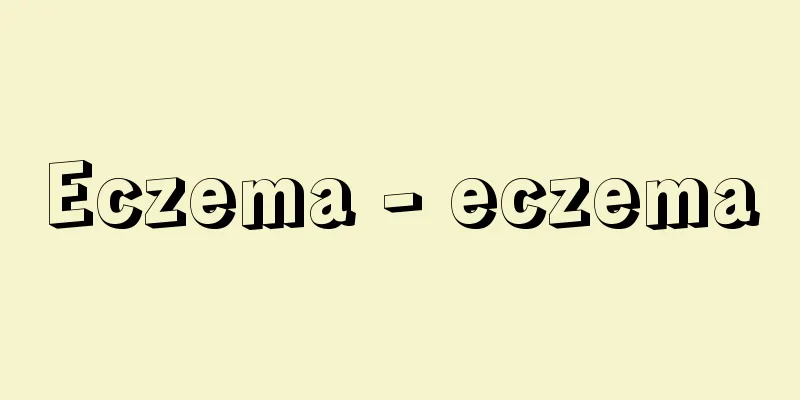Ishidaino

|
In the Edo period, taxes were paid in currency instead of rice. Examples of tax payments were the sanbuichiginno (one-third of a tax paid in silver), 50% of a tax paid in silver, and 10% of a tax paid in soybeans, which were implemented mainly in the Kinai region, the kaikin tax in the Shogunate territory of Yamato (Nara Prefecture), the hataeiinou (field tax paid in perpetuity) in Kanto, the daishogiri (large and small amount paid in perpetuity) in Koshu (Yamanashi Prefecture), and the hankokuhanei (half a koku and half an eternity) in Mutsu. In addition, depending on the price of the stone, there were also fixed stone payments, cheap stone payments, and wish stone payments. In many cases, the portion paid in stone was equivalent to the field tax, but in areas where it was difficult to transport rice as tax or in mountainous areas where there was little farmland, both fields and fields were paid in stone payments. In the Middle Ages, manors in remote areas began to pay taxes in cash, and in the Sengoku period, some areas were paid in currency under the Kanko system, but under the rice tax system established by the Taiko survey, rice tax became the norm. However, in 1603 (Keicho 8), the shogunate, through Okubo Nagayasu, instructed the Matsushiro domain in Shinshu to pay local produce such as hemp and miscellaneous grains, and to pay stone taxes in currency. In the shogunate territories of Omi (Shiga Prefecture), Settsu (Osaka Prefecture and Hyogo Prefecture), and Izumi (Osaka Prefecture), the payment of one-fifth of a share of silver was implemented from the end of the Keicho period (1596-1615) through the Genna period (1615-24), and in the flatland farming villages of the Kanto region, stone taxes were also implemented from the Keicho and Genna periods. In the Kanto region, the koku-dai payment was made at 1 kanmon (1 ryo of gold) per year until around 1633, but after that, it became 2.5 koku per year, and from around the Jokyo and Genroku eras (1684-1704), it became 1 koku 2.5 sho. When the perpetual tax payment for farmland was implemented in the Kanto region, the tax collection method changed from the rin-tori method based on kokudaka to the tan-tori method based on tanbetsu, and the tan-tori method became common in the Kanto region from the Kanbun and Enpo eras (1661-81). In this system, farmland taxes were collected by calculating the number of mon per tan. [Sadao Kawanabe] Source: Shogakukan Encyclopedia Nipponica About Encyclopedia Nipponica Information | Legend |
|
江戸時代、年貢を米で納めるかわりに貨幣で納めること。石代納には、畿内(きない)を中心とした地域で実施された三分一銀納(さんぶいちぎんのう)、五分一銀納、十分一大豆(だいず)銀納、大和(やまと)(奈良県)の幕領の皆(かい)金納、関東の畑永納(はたえいのう)、甲州(山梨県)の大小切(だいしょうぎり)、陸奥(むつ)の半石半永などがある。また、石代値段の違いにより定(じょう)石代、安(やす)石代、願(ねがい)石代などがある。石代納されるのは畑租にあたる部分が多いが、年貢米輸送の困難な地方や田地の少ない山間地域などでは田畑ともに石代納された。中世において遠隔地荘園(しょうえん)の年貢代銭納が展開し、戦国期には貫高(かんだか)制のもとで貨幣納がみられた地域もあったが、太閤(たいこう)検地による石高制のもとでは米納年貢が基本となった。だが、1603年(慶長8)、幕府は大久保長安(ながやす)を通じて信州松代(まつしろ)藩内に、麻、雑穀など、その地の生産物納や貨幣での石代納を指示した。近江(おうみ)(滋賀県)や摂津(せっつ)(大阪府・兵庫県)、和泉(いずみ)(大阪府)の幕領では、慶長(けいちょう)(1596~1615)末年から元和(げんな)期(1615~24)に五分一銀納が実施され、関東の平場(ひらば)農村においても、慶長・元和期から畑方石代納が実施された。関東では寛永(かんえい)10年(1633)ごろまで永(えい)1貫文(金1両)=5石替(かえ)で石代納されていたが、その後、永1貫文=2石5斗替となり、貞享(じょうきょう)・元禄(げんろく)(1684~1704)のころより1石2斗5升替となった。関東で畑永納が実施されると、石高を基準とした厘取(りんどり)法から、反別を基準とした反取(たんどり)法へと徴租法の転換がみられ、関東では寛文(かんぶん)・延宝(えんぽう)期(1661~81)以降、反取法が一般化した。そこでは、畑租は反当り永何文という方法で徴収された。 [川鍋定男] 出典 小学館 日本大百科全書(ニッポニカ)日本大百科全書(ニッポニカ)について 情報 | 凡例 |
<<: The true meaning of the national polity
>>: National polity ideology - kokutaishisou
Recommend
Minarette
… [Hoshikawa Kiyochika] [Ornamental varieties] Th...
Prosperity - Kaisei
...The area over the copper mine that connects th...
Alexandretta - Alexandretta (English spelling)
Former name of the city of Iskenderun in southern...
Montagu, ES (English spelling) MontaguES
…This report, submitted to the British Parliament...
Phyllostomidae
...A general term for mammals in the family Phyll...
Grindstone - grindstone
A stone used to sharpen and polish things. In a br...
Kita Shichidayu
A Noh actor in the early Edo period. The son of a...
Weissmuller, Johnny
Born June 2, 1904, near Timisoara, Romania [Died] ...
Udo Mountains - Udosanchi
...The western part (the Wanizuka Mountains in th...
binder
〘noun〙 (binder) 1. A type of stationery. A cover f...
Baldassare Longhena
Italian architect. Born in Venice, he studied und...
Holy Communion
...Because the liturgy of the sacraments begins t...
Elbe [river] - Elbe
A large river in central Europe. It originates in ...
Local History - Kyodoshi
〘 noun 〙 History related to one's hometown. ※G...
Hydroiodic acid (hydroiodic acid)
Aqueous solution of hydrogen iodide. Pure solution...









